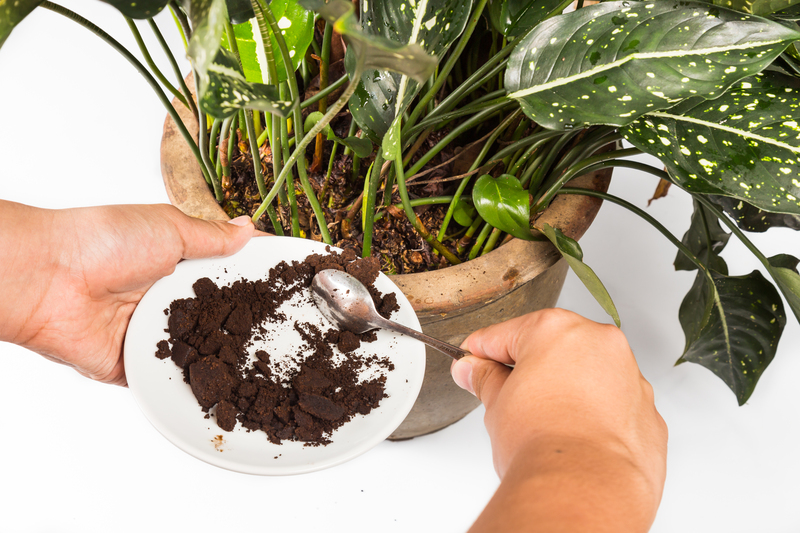Sustainable Living Through Vertical Gardening
Posted on 07/09/2025
Sustainable Living Through Vertical Gardening: A Comprehensive Guide
In our rapidly urbanizing world, the pursuit of sustainability within limited spaces becomes crucial. Discover how vertical gardening presents an innovative pathway to sustainable living, transforming not just how we garden, but how we approach food, resources, and community well-being.
What is Vertical Gardening?
Vertical gardening refers to the method of growing plants in vertically stacked layers, often using structures like trellises, shelves, walls, or hydroponic systems. Unlike traditional horizontal gardening, vertical gardens maximize space and can thrive in both outdoor and indoor environments, making them ideal for urban settings where space is a premium resource.
The Origins and Evolution of Vertical Gardens
While green walls and living walls may feel modern, the concept dates back centuries--think of the famed Hanging Gardens of Babylon, one of the Seven Wonders of the Ancient World! Modern innovations, however, have made vertical gardening accessible to anyone, anywhere.

How Vertical Gardening Contributes to Sustainable Living
Sustainability refers to practices that meet current needs without compromising the ability of future generations to meet theirs. Incorporating vertical gardens in urban homes offers numerous environmental, social, and economic benefits that align with sustainable living goals.
Environmental Benefits
- Efficient Land Use: Vertical gardening enables food production and greening even in the most space-limited environments, turning unused walls and corners into lush, productive spaces.
- Improved Air Quality: Plants act as natural air filters, absorbing pollutants and producing oxygen, thus improving urban air quality.
- Reduction of Urban Heat Island Effect: Green walls help regulate temperature by providing insulation and reflecting sunlight.
- Water Conservation: Many vertical gardening systems use drip irrigation or hydroponics, which can conserve up to 90% more water than traditional soil gardening.
- Biodiversity Enhancement: Encourages pollinators and biodiversity even in dense city landscapes.
Social & Economic Benefits
- Food Security: Growing your own vegetables, herbs, and fruits reduces reliance on commercially grown produce and mitigates supply chain disruptions.
- Educational Value: Vertical gardening is a hands-on way to teach children and adults about sustainability, botany, and nutrition.
- Mental Health: Interaction with plants and green spaces has been proven to reduce stress, boost mood, and enhance overall well-being.
- Energy Savings: Vertical gardens can help insulate buildings, reducing heating and cooling costs.
- Aesthetic Appeal: Living green walls beautify both indoor and outdoor spaces, increasing property value and community pride.
Types of Vertical Gardening Systems
Choosing the right system for your sustainable vertical gardening adventure depends on your space, budget, and desired crops. Here are some popular approaches:
1. Trellis and Climbing Structures
Perfect for edible plants like tomatoes, peas, beans, and cucumbers, trellises enable these crops to climb vertically, boosting yields and minimizing pests.
2. Modular Green Wall Panels
Living walls, or green wall panels, use modular trays or pockets filled with growing medium. These can be attached indoors or outdoors and host a wide variety of plants, from herbs to flowers to succulents.
3. Tower Gardens and Hydroponics
This soil-less option lets you grow plants using a nutrient-enriched water supply. Vertical hydroponic towers are perfect for small spaces and can yield substantial harvests year-round.
4. Hanging Pots and Pocket Planters
On balconies or fences, hanging containers or fabric pocket planters are affordable and flexible for small-scale vertical gardening at home.
5. Recycled and Upcycled Structures
Sustainability is further enhanced by repurposing pallets, gutters, or bottles for DIY vertical gardening solutions.
The Key Elements of a Sustainable Vertical Garden
Ensuring your vertical garden is truly sustainable involves more than just structure. Consider the following critical components:
- Choice of Plants: Focus on native, drought-resistant, or edible varieties to boost eco-friendliness and personal utility.
- Growing Medium: Use organic soil blends, coconut coir, or other renewable substrates for optimal growth and sustainability.
- Watering System: Drip irrigation or hydroponic systems conserve water and minimize runoff and waste.
- Natural Fertilizers: Compost tea or other organic fertilizers enrich plants without harmful chemicals.
- Efficient Design: Plan for ease of access, sunlight requirements, and regular maintenance to ensure long-term success.
Step-by-Step Guide to Starting Your Own Vertical Garden
Ready to embark on your sustainable living journey? Here's a practical, stepwise approach to create a thriving vertical gardening system in any space:
Step 1: Assess Your Space
Identify the wall, fence, balcony, or sunny window where your vertical garden will live. Consider both sunlight exposure and accessibility for maintenance.
Step 2: Choose a Structure
Decide between ready-made systems like green wall panels or DIY arrangements using recycled materials. Both can support sustainability, but upcycling reduces your environmental impact further.
Step 3: Select Your Plants
Match your choices to available light, space, and your culinary or ornamental preferences. Edibles like lettuce, strawberries, and herbs are popular for vertical gardens.
Step 4: Install the Growing Medium
Use organic potting mixes, coco coir, or hydroponic supports, ensuring they provide adequate drainage and aeration.
Step 5: Irrigation and Fertilization
Set up an irrigation system--drip lines or hand-watering from the top, depending on size. Supplement occasionally with organic compost tea or other natural fertilizers.
Step 6: Plant and Maintain
Install your plants, arrange attractively, and monitor for water needs, pests, and general health. Harvest regularly for the best yields and ongoing sustainability.
Best Plants for Sustainable Vertical Gardening
Certain plants thrive particularly well in vertical gardens and contribute to both beauty and practicality. Here are some top recommendations:
- Herbs: Basil, parsley, oregano, thyme, mint, and chives perform exceptionally well.
- Leafy Greens: Spinach, kale, lettuce, arugula, and Swiss chard grow rapidly and are highly nutritious.
- Strawberries: Compact and productive, ideal for hanging pockets or towers.
- Tomatoes: Choose compact or cherry varieties; use sturdy supports for heavier fruit.
- Beans and Peas: Train easily up trellises, supplying ample food from minimal space.
- Succulents: For decorative walls with low water needs, mix varieties for maximum visual appeal.
Challenges of Vertical Gardening and How to Overcome Them
While vertical gardening promotes sustainable urban living, it isn't entirely without hurdles. Here's how to anticipate and address common issues:
- Water Drainage: Overwatering or poor drainage can damage roots. Use well-draining soil and avoid blockages in hydroponic systems.
- Sunlight Limitations: If natural light is restricted, consider supplemental grow lights for indoor vertical gardens.
- Pests and Diseases: Monitor for aphids, mites, or fungal issues; practice integrated pest management using neem oil or insecticidal soaps.
- Structural Stability: Ensure your wall or balcony can support the weight of the garden, especially when saturated with water.
- Nutrient Management: In hydroponics, monitor nutrient levels closely. In soil, top up with compost and organic amendments regularly.
Vertical Gardening Success Stories
Across the globe, innovative communities and individuals are using vertical gardens to revolutionize sustainability:
- Singapore: Nicknamed the "Garden City," Singapore's vertical gardens on skyscrapers have dramatically improved urban air quality and biodiversity.
- New York City: Rooftop and wall gardens provide fresh produce to local communities and beautify cityscapes.
- Schools and Hospitals: Living green walls in educational and healthcare institutions promote well-being, learning, and healthier environments.
- Home Gardeners: Around the world, apartment dwellers are turning balconies and kitchens into productive, sustainable gardens.
Merging Technology with Vertical Gardening for Sustainability
Modern vertical gardening systems increasingly harness smart technology. Automated irrigation, climate monitoring, and even AI-powered grow lights make it easier than ever to maintain bountiful, water-wise, and energy-efficient gardens.
- Smart Sensors: Real-time feedback on soil pH, moisture, and temperature ensures optimal plant health.
- Automated Watering: Timers and remote control systems prevent over- or under-watering.
- IoT Integration: Growers can manage their vertical gardens through smartphone apps for ultimate convenience and resource efficiency.

FAQs: Sustainable Living Through Vertical Gardening
- Is vertical gardening expensive? Initial setup costs vary, but DIY options using upcycled materials can be highly affordable. Over time, homegrown food and reduced energy expenses yield savings.
- Do I need a lot of sunlight? Most vertical gardens require 4-6 hours of light daily. For shaded homes, supplement with LED grow lights ensures plants' health.
- Can I grow a full meal's worth of food? While it may not supply all your dietary needs, a well-designed vertical garden can supply fresh greens, herbs, small fruits, and some vegetables for everyday meals.
- How much maintenance does a vertical garden require? Once established, vertical gardens need less maintenance than traditional soil beds--mainly watering, cleaning, and occasional pruning or harvesting.
Conclusion: Green Living, Elevated
Embracing sustainable living through vertical gardening offers a practical, eco-friendly solution to many challenges of modern urbanization. Whether you are passionate about urban greening, resource conservation, or growing your own organic food, vertical gardening brings these goals within reach--even in the smallest city apartments.
By harnessing the power of upward growth, you contribute to a healthier environment, gain access to fresh produce, and inspire your community to embrace the sustainability movement.
Let your walls come alive and your lifestyle flourish--start your vertical gardening journey today!

